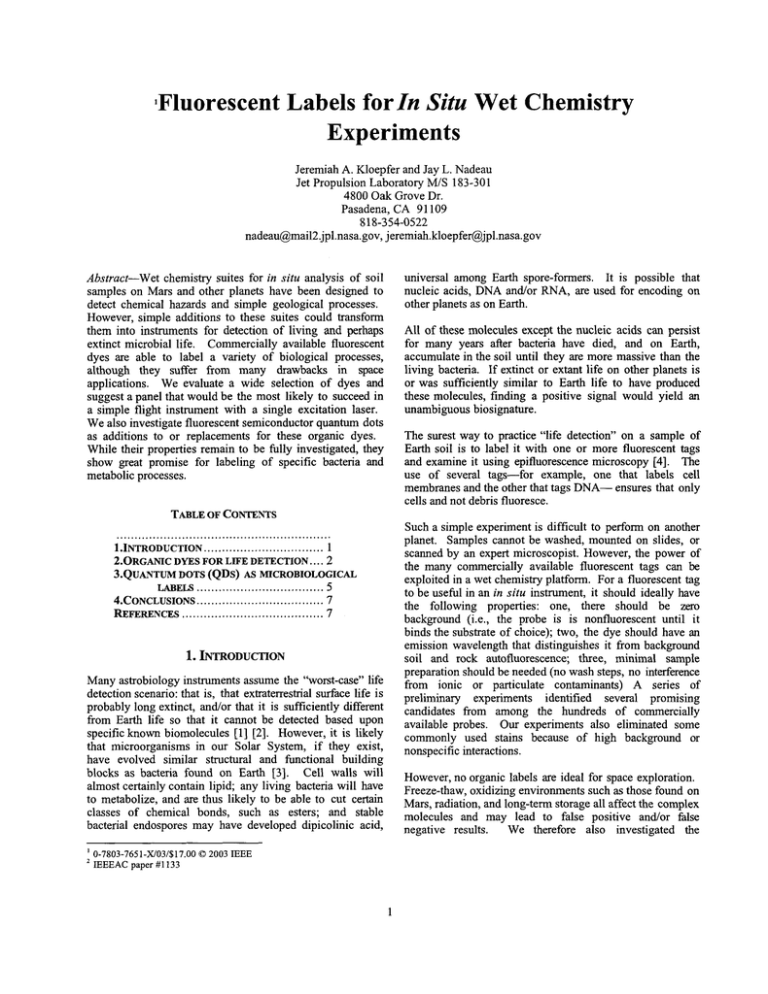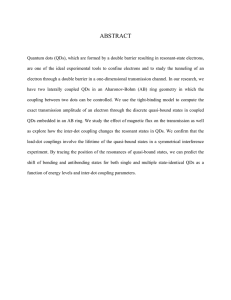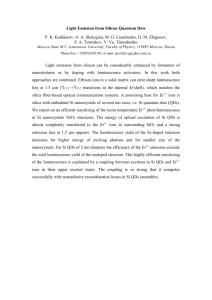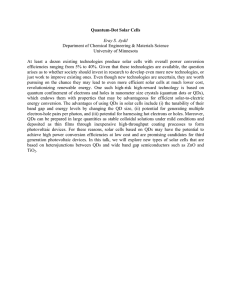as a PDF
advertisement

IFluorescent Labels for In Situ Wet Chemistry Experiments Jeremiah A. Kloepfer and Jay L. Nadeau Jet Propulsion Laboratory MIS 183-301 4800 Oak Grove Dr. Pasadena, CA 91 109 818-354-0522 nadeau@mail2.jpl.nasa.gov,jeremiah.kloepfer@jpl.nasa.gov universal among Earth spore-formers. It is possible that nucleic acids, DNA andor RNA, are used for encoding on other planets as on Earth. Abstract-Wet chemistry suites for in situ analysis of soil samples on Mars and other planets have been designed to detect chemical hazards and simple geological processes. However, simple additions to these suites could transform them into instruments for detection of living and perhaps extinct microbial life. Commercially available fluorescent dyes are able to label a variety of biological processes, although they suffer from many drawbacks in space applications. We evaluate a wide selection of dyes and suggest a panel that would be the most likely to succeed in a simple flight instrument with a single excitation laser. We also investigate fluorescent semiconductor quantum dots as additions to or replacements for these organic dyes. While their properties remain to be fully investigated, they show great promise for labeling of specific bacteria and metabolic processes. All of these molecules except the nucleic acids can persist for many years after bacteria have died, and on Earth, accumulate in the soil until they are more massive than the living bacteria. If extinct or extant life on other planets is or was sufficiently similar to Earth life to have produced these molecules, finding a positive signal would yield an unambiguous biosignature. The surest way to practice “life detection” on a sample of Earth soil is to label it with one or more fluorescent tags and examine it using epifluorescence microscopy [4]. The use of several tags-for example, one that labels cell membranes and the other that tags DNA- ensures that only cells and not debris fluoresce. TABLE OF CONTENTS Such a simple experiment is difficult to perform on another planet. Samples cannot be washed, mounted on slides, or scanned by an expert microscopist. However, the power of the many commercially available fluorescent tags can be exploited in a wet chemistry platform. For a fluorescent tag to be useful in an in situ instrument, it should ideally have the following properties: one, there should be zero background (i.e., the probe is is nonfluorescent until it binds the substrate of choice); two, the dye should have an emission wavelength that distinguishes it from background soil and rock autofluorescence; three, minimal sample preparation should be needed (no wash steps, no interference from ionic or particulate contaminants) A series of preliminary experiments identified several promising candidates from among the hundreds of commercially available probes. Our experiments also eliminated some commonly used stains because of high background or nonspecific interactions. ........................................................... INTRODUCTION ................................. 1 2.ORGANIC DYES FOR LIFE DETECTION.. .. 2 3.QUANTUM DOTS (QDS) AS MICROBIOLOGICAL 5 LABELS ................................... 4.cONCLUSIONS ................................... 7 REFERENCES ....................................... 7 1. INTRODUCTION Many astrobiology instruments assume the “worst-case” life detection scenario: that is, that extraterrestrial surface life is probably long extinct, and/or that it is sufficiently different from Earth life so that it cannot be detected based upon specific known biomolecules [l] [2]. However, it is likely that microorganisms in our Solar System, if they exist, have evolved similar structural and functional building blocks as bacteria found on Earth [3]. Cell walls will almost certainly contain lipid; any living bacteria will have to metabolize, and are thus likely to be able to cut certain classes of chemical bonds, such as esters; and stable bacterial endospores may have developed dipicolinic acid, However, no organic labels are ideal for space exploration. Freeze-thaw, oxidizing environments such as those found on Mars, radiation, and long-term storage all affect the complex molecules and may lead to false positive and/or false negative results. We therefore also investigated the ’ 0-7803-7651-X/03/$17.00 02003 IEEE * IEEEAC paper #I I 33 1 wide range of emission wavelengths, from blue to infrared. Wheat germ agglutinin (WGA), which binds to sialic acid and N-acetylglucosaminyl residues, is one of the most commonly used lectins in cell biology and has many applications including adhering to Gram positive but not Gram negative cell walls [8]. The addition of greenfluorescent WGA to soil samples containing live or dead Gram positive bacteria leads to very strong, distinct fluorescent cell outlines (Fig. 1 E). The background is high in spectrofluorometric measurements because unbound dye is fluorescent (not shown), but unbound dye remains in solution, does not adhere to minerals, and has little effect on images of cells taken by fluorescence microscopy. feasibility of using fluorescent semiconductor nanocrytals (quantum dots or QDs) as probes for specific microbiological structures and enzymes. Nanocrystals are insensitive to temperature extremes, proton irradiation [5], and aging. They have been conjugated to biomolecules for labeling of complex cells [6]. In our experiments, QDs conjugated to redox-active amino acids and purine bases yielded metabolism-specific probes with low to zero background. However, some of the observed phenomena were poorly reducible or difficult to explain. Futher work is necessary to characterize the complex interactions that occur between conjugated QDs and microorganisms. 2. ORGANIC DYES FOR LIFE DETECTION Many DNA stains interact with minerals Extraterrestrial wet chemistry It was rapidly apparent that some of the most commonly used stains in microbiology could not be used on unfiltered soil samples because of strong binding to mineral particles. Acridine Orange and DAPI, both nucleic acid stains, produced overwhelming background labeling that swamped cell labeling even when bacteria were present in high numbers (data not shown). The only unambiguously positive results for nucleic acid staining were those using dyes which are completely nonfluorescent in the absence of nucleic acids and which are designed to label living cells (that is, they must be transported inside the bacterium in order to interact with the nucleic acid). Dyes for labeling of dead cells, in which the nucleic acid is exposed, all showed excessive background labeling. Although unambiguous, zero-background staining was achieved with live cell labeling, the signal was often difficult to distinguish (Fig. 1 F). Suites for in situ wet chemistry experiments began with the Mars environmental compatibility assessment (MECA), which consisted of a “teacup” into which a soil sample could be placed. An array of ion sensitive electrodes inserted into the teacup measured the concentrations of a wide range of ions [7]. MECA was scheduled to fly on the Mars 2001 lander, but because of mission cancellation has not been used on Mars. More recent designs for wet chemistry experiments start with a similar platform, but usually contain 10 or more individual test tubes rather than a single “teacup.” This allows electrodes and other probes to operate with less ambiguity. Flight-qualified prototypes of such instruments are available commercially. With such an instrument, a dye could be added to each test tube without interfering with electronic or other analysis, thus acting as an added bonus. The only instrumentation required would be a diode laser and fluorescence camera; flight-qualified versions of these components are readily available. In our tests of organic dyes, we mimicked as closely as possible the probable conditions of such a chemistry suite. Soil samples from different environments were mixed with a weakly ionic “leaching solution” designed to extract soluble components; the leaching solution consists of M concentrations of sodium perchlorate, magnesium chloride, calcium chloride, ammonium nitrate, and potassium nitrate. Samples were stirred but not vortexed, centrifuged, or filtered. Unless the dye required heating, all experiments were performed at 20 “C. Experiments were performed both on soils sterilized by autoclaving and on soils sterilized and afterwards seeded with a specific number of live or heat-killed bacteria of a known species. Investigation of fluorescence was performed using an epifluorescencemicroscope with an Hg lamp and a modified DAPI filter (Excitation 360/30 nm, dichroic 400 nm, 435 nm longpass out) or a fluorescein filter (Ex. 470/20, dichroic 500 nm, Em. 515 nm longpass) (see Fig. 1 A-D). Figure 1- Fluorescent labels for in situ bacterial detection. Scale bar = 5 pm. (A) Antarctic rock sample and (B) Mono lake sandstone, both excited with 360130 W light, emission 435 longpass. Most autofluorescence is in the blue range, with some yellows; strong reds and greens are notably absent. (C) Staphylococcus epidermidis and (D) Schizosaccharomyces sp., same conditions; again, most fluorescence is blue. (E) Micrograph of S. epidermidis in pulverized soil and nutrient medium, labeled with Oregon Fluorescent wheat germ agglutinin yields distinctive cell images Fluorescent lectins are a straightforward conjugate of a protein to a fluorophore, and are commercially available in a 2 Green-wheat germ agglutinin. The fluorescein filter used here (Ex. 470/20) fails to excite either the mineral or bacterial autofluorescence, leading to a clean signal. (F) The same fluorescein excitation efficiently excites both Oregon Green-WGA and the red dye SYTO Red (Molecular Probes), a DNA stain for live bacteria. Cells are labeled in soil culture and stand out against the background, though not so clearly as with WGA. Up to three dyes may be used with a single laser excitation Many of the fluorescent probes tested are available conjugated to many different fluorophores. However, the addition of more than one laser to an in situ instrument increases cost and potential for failure. Hence, it would be ideal to be able to excite several probes with the same laser line and to obtain visually distinct outputs with each. “Off-on” dyes generate useful spectral signals Because of the widely varying Stokes shifts in the different types of organic dyes, such multi-labeling is possible for at least three colors. The laser of choice is a blue 405 nm line, which can efficiently excite a selected lipid probe, DNA stain, and an esterase-labeling dye (Fig. 3). While both WGA and live-cell DNA stains yield useful visible signals provided that samples can be photomicrographed with good resolution, neither produces spectral peaks over background upon spectrofluorimetry. The background for WGA staining is too high, and the signal for the DNA stains is too weak. However, there are many dyes available that fluoresce only in the presence of a given cellular structure or function which provide distinct spectral peaks over mineral and bacterial autofluorescence. Two of the best probes for this purpose were 5chloromethylfluorescein diacetate (CellTracker) (Molecular Probes) and 1-anilinonaphthalene-8-sulfonicacid (ANS) (Sigma). CellTracker diffuses across the membranes of live cells and is cleaved by nonspecific esterases, labeling a variety of intracellular components without assuming any specific Earth-like enzymes. ANS is a lipophilic dye that is nonfluorescent in aqueous solution. Both of these yield strong spectral peaks in soil samples (Fig. 2). Emission Inm) Figure 2 -Zero-background labeling of esterases and lipids. (A) Cell Tracker is nonfluorescent in the absence of living bacteria. Experiment conducted under realistic conditions with Mono Lake soil sample, either sterilized or doped with lo6 S. aureus bacteridg. (B) The lipophilic tracer ANS also displays no fluorescence in aqueous soil samples unless biological membranes are present (bacteria may be living or killed). - 3 Figure 3-Wide excitation peaks and differing Stokes shifts allow fluorescent probes with widely different emission spectra to be excited with a single laser line (405 nm shown by bar). (A) Membrane probes show large Stokes shifts. The spectrum shown is for the red- to infrared-emitting lipophilic tracer FM4-64; there is a wide choice of membrane probes that exhibit this same feature. (B) Ethidium Br, a DNA stain, shows a moderate Stokes shift, emitting in the green when excited with blue. (C) Cell Tracker Blue exhibits blue fluorescence when excited with the 405 nm laser line. Summary and preliminary hardiness tests Dyes that were eliminated from further consideration, and some dyes that were considered possibly useful, are summarized in Table 1 . All dyes considered of potential use were subjected to 5 rounds of freeze-thaw and storage at -20 "C for 6 mo, without detectable change in performance. However, CellTracker dyes were destroyed by peroxide and by long-term storage in aqueous solutions; they were only stable when stored desiccated. Further experiments will determine more fully the conditions under which these probes may be stored and used. Table 1-Fluorescent probes considered for possible use in life detection experiments. Those in shaded boxes were deemed unacceptable in preliminary experiments for the reasons given. All reagents available from Molecular Probes except dipicolinic acid assay (Ocean Optics). Ex./Em. = excitation and emission wavelengths. I Ex-'Em. Many cells) I CellTracker I Many (esterase enzymes) I Features I Only fluoresces if DNA is present. Sometimes difficult to SAA I No fluorescence in absence of active enzyme (i.e., living bacteria). Non-earthspecific: does not presuppose enzyme structure Only fluoresce in the presence of lipids. Specific for cell membranes; not I 4 NanoOrang e Protein 470/570 highly earth-centric Must be heated to 95 OC. No background. 3. QUANTUM DOTS (QDS) AS MICROBIOLOGICAL LABELS Fluorescent CdSe QDs in this study were synthesized using a recently developed method [9] in which CdAcetate and selenium metal take the place of the usual organometallic precursors. The elemental Se is incubated for at least 24 h in trioctylphosphine oxide (TOPO), generating TOP-Se, which is then injected with the Cd precursor into a TOPO solution at 300-350°C and baked for 30s - 30 min. Resulting QDs are washed several times in methanol, in which they are insoluble, and finally dissolved in hexane or dichloromethane. These bare CdSe nanocrystallites are passivated with TOPO. a, 0 c a m, 0 2 P 500 520 140 a I ._ S 53 8 S 8 F v) -s U Figure 4 -PL properties of CdSe QDs can be altered by chemical conjugation. (A) Visible emission spectra from 5 independent preparations of QDs. Excitation wavelength, 400 nm. (B) Green-emitting (gQD) and yellow-emitting (yQD) QDs in PBS, compared with the same concentration of QDs conjugated via amide bonds to adenine (yAd and gAd). (C) Yellow-emitting QDs (yQD), and after conjugation to tryptophan (yTryp). QDs have several advantages over organic dyes for in situ life detection applications. In particular, they demonstrate many emission wavelengths for single excitation wavelength (Fig. 4A). More importantly, their band structure may allow them to be turned on and off chemically, so that they can be made into zero-background labels that exhibit photoluminescence (PL) only in the presence of a desired compound. If a QD is conjugated to a compound with a small reduction (or oxidation) potential, the electron (or hole) may be transferred from the excited state of the QD into the conjugate. The PL is quenched in this process, as the electrodhole pair is no longer available to combine radiatively. Interestingly, when incubated with live, actively metabolizing bacteria for 3 hr, quenched QD-adenine and QD-tryptophan conjugates show a PL return that is associated only with bacterial cells, clearly evident in both spectra and by visual inspection (Fig. 5, 6). There is no background fluorescence. No fluorescence return is seen in bacteria killed by freeze-thaw or heat shock (Fig. 6 A), or in bacteria metabolically inhibited by the metal ion chelator EDTA (Fig. 6 C), or in mutants unable to utilize the conjugated molecule (not shown; to be published elsewhere). In addition, D- and L-tryptophan, while photophysically identical, show different spectra after unquenching in bacterial cells (Fig. 6 D, E). Many experiments have been done using electron acceptors, which have been shown to quench fluorescence of QDs [lo], but fewer studies have been done with hole acceptors [ 111. However, many useful biological molecules are hole acceptors, among them the DNA purine bases (adenine and guanine) and the amino acids tyrosine, tryptophan, and phenylalanine. Conjugation of QDs to any of these molecules leads to almost complete quenching of PL when excited at 400 nm (Fig. 4 B). ._ d c = ge a, 8 a F 9 ii 640 h In order to be relevant to biological applications, the properties of the QDs in water or physiological saline must be investigated. “Cap exchange” using mercaptoacetic acid [6] replaces the TOPO with a water-soluble layer, and allows the QDs to be dissolved in aqueous solution. Carboxylate groups coat the QD and are accessible to the solution. In these studies, solubilized QDs are stored in phosphate buffered saline (PBS), pH 7.5, unless stated otherwise. Characterization by TEM, AFM, and FTIR spectroscopy confirmed their physical and surface bond properties (not shown; to be published elsewhere). h 540 560 580 600 620 Emission (nm) This phenomenon is highly reproducible in a variety of bacteria, including Staphylococcus aureus, S. epidemzidis, Bacillus subtilis, and E. coli. Controls using bacterial growth medium or “conditioned” growth medium in which cells have grown and been removed by centrifugation show no fluorescenceunquenching. 300 250 200 However, while results with living cells are highly consistent, the PL of QDs and conjugates in aqueous solutions are sensitive to temperature, light, oxidationreduction potential, and time in ways that have not been fully quantified. Further experiments will determine the 150 100 50 0 5 Fmissinn lnml mechanisms of the phenomena seen and the experimental conditions under which the metabolic sDecificitv is valid. 3500 Emission (nm) 440 480 520 560 600 640 680 Emission (nm) Figure 5 - Fluorescence unquenching of QD-adenine and QD-tryptophan conjugates when exposed to live bacteria. (A) Quantum dots (QDs), solubilized, in phosphate-buffered saline (PBS). (B) The same QDs conjugated to tryptophan. There is some slight yellow color left, but it is weak and blue-shifted. (C) Conjugated to adenine. The blue is nonspecific crystal fluorescence. All yellow has vanished. @) QD-adenine + Staphylococcus aureus, 3 h incubation. This experiment has been repeated >IO times with 5 independent QD preparations and 3 bacterial species. (E) QD-D-tryptophan + S. aureus, 3 h incubation. (F) QDtryptophan + S. aureus, same image as (E) after 2 min photobleach. The remaining signal is close to that of the original QDs in (A). 3500 3000 2500 3 2000 8 1000 2 500 0 -500 I ... I . I .. I . . . I . . I . I a , 440 480 520 560 600 640 680 I I m I I I 500 2000 550 600 650 700 550 600 650 700 Emission (nm) 1500 1000 500 4 -500 c -1000 450 500 Emission (nm) Figure 6- Spectra and images of quenched QD- adenine and QD-tryptophan after incubation with S. aureus. QDs in this experiment were green-emitting (PL peak 550 nm). Y-axes give PL intensity in arbitrary units. Autofluorescence, obtained from identically prepared samples of bacteria incubated with the reagent alone (adenine or tryptophan) in the absence of QDs, were subtracted from all of the spectra shown. (A) Heat-shock-killed S. aureus with QD-adenine. (B) Live S. aureus with QD-adenine. (C) EDTA-inhibited S. aureus with QD-adenine. @) Live S. aweus with QD-Dtryptophan. (E) Live S. aureus with QD-L-tryptophan. The spectral peaks are blue-shifted from the peak of the original QDs except in the case of one of the D-tryptophan peaks. 5 1500 n -800 -1200 450 Emission (nm) 6 4. CONCLUSIONS Fluorescent probes that respond to the presence of specific biological molecules and/or metabolic processes would be an invaluable addition to a wet chemistry suite for planetary exploration. However, choosing a selection of probes that is robust enough to survive space flight and extraterrestrial conditions and that would provide an unambiguous signature of mircrobial life is a difficult task. Of the commercially available probes, many of those that fluoresce only in the presence of an active enzyme or other molecule provide sufficiently low background staining that they can be used in unfiltered samples containing soil and rock. The possibility of false positives and negatives still arises due to nonspecific probe activation or degradation. It is also tricky, although not impossible, to achieve 2 or 3 visually separable spectra with a single excitation line. [9] M. S . Wong and G. D. Stucky, "The Facile Synthesis of Nanocrystalline Semiconductor Quantum Dots," Synthesis, Functional Properties and Applications of Nanostructures, Materials Research Society Symposium Proceedings, vol. 676, pp. Y2.3.1-Y2.3.5, 2002. [lo] C. Burda, T. C. Green, S. Link, and M. A. ElSayed, "Electron shuttling across the interface of CdSe nanoparticles monitored by femtosecond laser spectroscopy," J Phys Chem B , vol. 103, pp. 1783-1788, 1999. [Ill C. Landes, C. Burda, M. Braun, and M. A. ElSayed, "Photoluminescence of CdSe nanoparticles in the presence of a hole acceptor: n-butylamine," J Phys Chem B , V O ~ .105, pp. 2981-2986, 2001. Jeremiah A. Kloepfer received his B.Sc. degree in chemistryfrom the University of South Carolina in 1996 and completed his doctoral work in physical chemistry at the University of Southern California in 2002. He is currently a postdoctoral researcher at CaltechAVASA JPL where he is studying the photophysical properties of biomolecule-semiconductor nanocrystal conjugates and m as cellular labels. her B.A. in biology in in theoretical physics iversity of Minnesota. She is currently a staff scientist in JPL's Center for Life Detection, involved in low-cost instruments for in situ biochemistry. CdSe quantum dots conjugated to biomolecules are an alternative set of probes that need to be studied further. Intriguing results suggesting metabolic specificity and "offon" behavior of the QDs promise to yield a range of interesting biosensors provided that the QDs themselves and their interactions with the conjugated molecule are fully understood. This next generation of labels may make designing fluorescent dyes for planetary applications more tractable. REFERENCES [l] B. L. Beard, C. M. Johnson, L. Cox, H. Sun, K. H. Nealson, and C. Aguilar, "Iron isotope biosignatures," Science, vol. 285, pp. 1889-92, 1999. [2] R. E. Blake, J. C. Alt, and A. M. Martini, "Oxygen isotope ratios of P04: an inorganic indicator of enzymatic activity and P metabolism and a new biomarker in the search for life," Proc Natl Acad Sci U S A , vol. 98, pp. 2148-53, 2001. [3] W. L. Davis and C. P. McKay, "Origins of life: a comparison of theories and application to Mars," Orig Life Evol Biosph, vol. 26, pp. 61-73, 1996. [4] Y . Kawasaki, "[Way to the detection of Mars life]," Biol Sci Space, vol. 10, pp. 271-82, 1996. [5] R. Leon, "Changes in luminescence emission induced by proton irradiation: InGaAdGaAs quantum wells and quantum dots," Appl Phys Lett, vol. 76, pp. 20742076, 2000. [6] W. C. Chan and S . Nie, "Quantum dot bioconjugates for ultrasensitive nonisotopic detection," Science, vol. 281, pp. 2016-8., 1998. [7] S. J. West, M. S. Frant, X. Wen, R. Geis, J. Herdan, T. Gillette, M. H. Hecht, W. Schubert, S. Grannan, and S. P. Kounaves, "Electrochemistry on Mars," Am Lab, V O ~ .3 1, pp. 48-54, 1999. [8] R. K. Sizemore, J. J. Caldwell, and A. S . Kendrick, "Alternate gram staining technique using a fluorescent lectin," Appl Environ Microbiol, vol. 56, pp. 2245-7, 1990. 7



